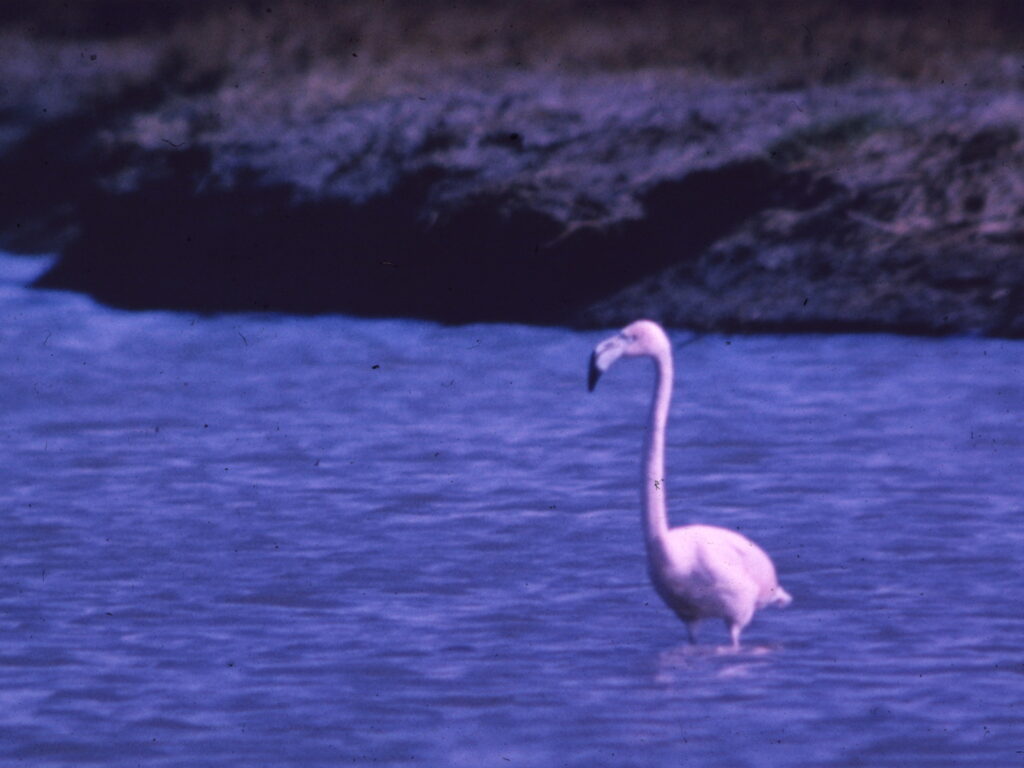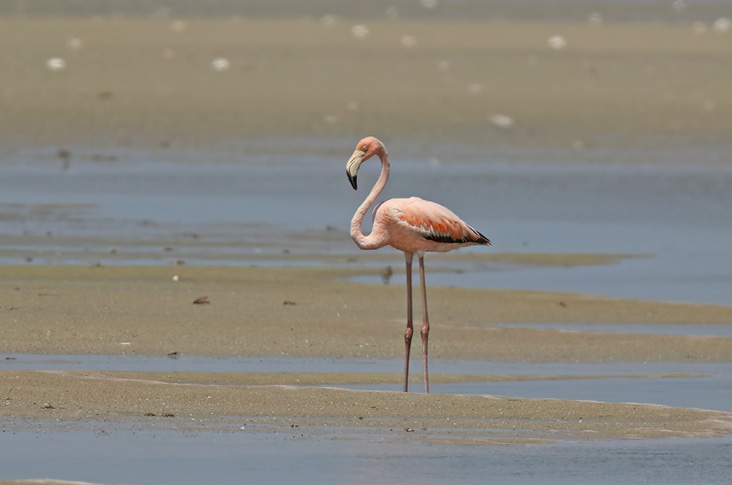
American Flamingo, Plum Island, Essex, 16 Sep 1964. Photographer unknown.
4 records
| MARC number | Decision | Species | # | Location | County | Arrival | Departure | Observers | Report |
|---|---|---|---|---|---|---|---|---|---|
| 1964-002 | NA | American Flamingo | 1 | Plum Island | Essex | 9/16/1964 | 10/24/1964 | observer unknown (ph) | 14 |
| 1964-003 | NA | American Flamingo | 1 | Natick | Middlesex | 5/20/1965 | 5/20/1965 | observer unknown (ph) | 14 |
| 2024-004 | A | American Flamingo | 1 | Dennis Chapin Beach | Barnstable | 6/2/2024 | 6/2/2024 | Sam Roth* (ph), Richard Gifford* (ph), m. ob. | 27 |
| 2024-005 | A | American Flamingo | 1 | Dennis Chapin Beach | Barnstable | 7/15/2024 | 7/15/2024 | M. J. Foti* (ph), m.ob. | 27 |
1960s Sightings
There are two records for the state from the mid-1960s. In both cases, the thorny issue of provenance was considered, because American Flamingos have been kept somewhat frequently in collections.
Evidence relating to the Natick bird strongly suggested that it was an escapee, because one of two birds imported from the Dominican Republic by a nearby Westwood resident had escaped prior to the sighting (Bagg and Emery 1965). The Natick record was unanimously considered in the third round to be of non-natural provenance.
The Plum Island bird had no clear connection to the Westwood incident, and garnered two votes to accept, but the majority was concerned that the date, location, and dull plumage of the bird were not suggestive of natural origin. Some stray flamingos have been treated as wild by Records Committees along the East Coast; for example, an adult photographed at Assateague Island, Worcester, MD, late June–September 3, 1972 (Rowlett 1972), was accepted as wild by the MD/DCRC (Davis 2005), in part due to its appearance after Hurricane Agnes. Similarly, many other records away from areas of regular occurrence in the Bahamas, southernmost Florida, and the Yucatan, have been tied to the passage of hurricanes (McNair and Gore 1998). In contrast, the two Massachusetts records from the mid-1960s were not tied to tropical storms.
2024 Sightings
Although over a month apart, the two records from different dates pertained to an individually identifiable second-calendar-year American Flamingo, which had a remarkable tale (see below); the MARC formally considers these records to pertain to the same individual.
The occurrence of American Flamingo outside its regular range in the United States—essentially, away from South Florida and the Gulf coast—has always been a subject of debate: we know escapees occur, but do occasional birds stray north? Given that some records seem to be associated with hurricanes, does their passage explain some of the extralimital records on the East Coast (Veit and Petersen 1993)? Uncertainty about the potential for hurricanes to transport American Flamingos evaporated in August and September 2023, as Hurricane Idalia crossed between the Yucatan Peninsula and Cuba and entrained a large number of American Flamingos that were presumably making their regular movement between those areas. It made landfall in the Florida Panhandle around dawn on August 30 and tracked inland to the Carolinas before heading out to sea. While lackluster for seabird vagrants, the storm remarkably transported flamingos to 18 U.S. states, many of which established first records (Davis and Ramírez-Garofalo 2024). The pattern was undeniable and some birds remained well into late fall as far north as Cape Hatteras, with others overwintering in Texas, South Carolina, and Georgia and on Florida’s northeast coast.

Dennis Chapin Beach July 15, 2024. Photograph by Peter Trimble.
When one appeared on Long Island, New York, on May 31, 2024, it was immediately presumed to be a holdover from the previous fall. That bird stayed on Long Island for a few days, moving between a couple of sites, and then went missing on June 3, last seen flying east. It appeared on Cape Cod the same day, but was gone the next day, with two reports from Connecticut of flamingos in flight in subsequent days. The bird subsequently returned to New York for parts of June and early July, with a short absence, during which time there was a credible American Flamingo sighting in Delaware, and then was back in New York up until July 14. So its reappearance in Massachusetts—the very next day—was not wholly unexpected, and Rhode Island birders were thrilled when the bird finally settled down at Briggs Marsh, Newport County, cooperating for birders from July 18 to August 12. It has not been seen since, but American Flamingo numbers in the southern United States remain at modern record levels.
